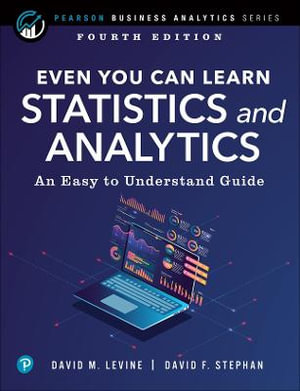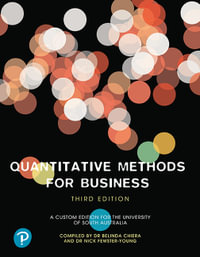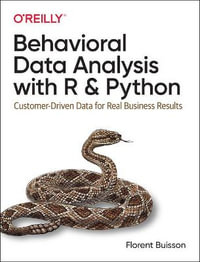
Even You Can Learn Statistics and Analytics
An Easy to Understand Guide
By: David Levine, David Stephan
Paperback | 8 June 2022 | Edition Number 4
At a Glance
400 Pages
23.4 x 17.8 x 2.5
Paperback
RRP $54.95
$54.75
or 4 interest-free payments of $13.69 with
orAims to ship in 7 to 10 business days
When will this arrive by?
Enter delivery postcode to estimate
Now fully updated for "big data" analytics and the newest applications, Even You Can Learn Statistics and Analytics, Fourth Edition is the practical, up-to-date introduction to statistics an analyticsâ"for everyone!
One easy step at a time, you''ll learn all the statistical techniques you''ll need for finance, marketing, quality, science, social science, or anything else. Simple jargon-free explanations help you understand every technique, and realistic examples and worked problems give you all the hands-on practice you''ll need. This edition contains more practical examples than everâ"all updated for the newest versions of Microsoft Excel. You''ll find downloadable practice files, templates, data sets, and sample modelsâ"including complete solutions you can put right to work in business, school, or anywhere else. Learn how to do all this, and more:
- Apply statistical techniques to analyze huge data sets and transform them into valuable knowledge
- Construct and interpret statistical charts and tables with Excel or OpenOffice.org Calc 3
- Work with mean, median, mode, standard deviation, Z scores, skewness, and other descriptive statistics
- Use probability and probability distributions
- Work with sampling distributions and confidence intervals
- Test hypotheses with Z, t, chi-square, ANOVA, and other techniques
- Perform powerful regression analysis and modeling
- Use multiple regression to develop models that contain several independent variables
- Master specific statistical techniques for quality and Six Sigma programs
Hate math? No sweat. You''ll be amazed at how little you need. Like math? Optional âEquation Blackboardâ sections reveal the mathematical foundations of statistics right before your eyes! Thought you couldn''t learn statistics? You canâ"and you will!
Chapter 1 Fundamentals of Statistics. 1
1.1 The First Three Words of Statistics. . . . . . . . . . . . . . . . . . . . . . . . . . . . . . . . . . 2
1.2 The Fourth and Fifth Words. . . . . . . . . . . . . . . . . . . . . . . . . . . . . . . . . . . . . . . 4
1.3 The Branches of Statistics. . . . . . . . . . . . . . . . . . . . . . . . . . . . . . . . . . . . . . . . . 4
1.4 Sources of Data . . . . . . . . . . . . . . . . . . . . . . . . . . . . . . . . . . . . . . . . . . . . . . . . 5
1.5 Sampling Concepts . . . . . . . . . . . . . . . . . . . . . . . . . . . . . . . . . . . . . . . . . . . . . 7
1.6 Sample Selection Methods. . . . . . . . . . . . . . . . . . . . . . . . . . . . . . . . . . . . . . . . 8
Chapter 2 Presenting Data in Tables and Charts . 15
2.1 Presenting Categorical Variables. . . . . . . . . . . . . . . . . . . . . . . . . . . . . . . . . . . 15
2.2 Presenting Numerical Variables . . . . . . . . . . . . . . . . . . . . . . . . . . . . . . . . . . . 23
2.3 "Bad" Charts. . . . . . . . . . . . . . . . . . . . . . . . . . . . . . . . . . . . . . . . . . . . . . . . . . 29
Chapter 3 Descriptive Statistics. 45
3.1 Measures of Central Tendency. . . . . . . . . . . . . . . . . . . . . . . . . . . . . . . . . . . . 45
3.2 Measures of Position. . . . . . . . . . . . . . . . . . . . . . . . . . . . . . . . . . . . . . . . . . . . 49
3.3 Measures of Variation. . . . . . . . . . . . . . . . . . . . . . . . . . . . . . . . . . . . . . . . . . . 54
3.4 Shape of Distributions. . . . . . . . . . . . . . . . . . . . . . . . . . . . . . . . . . . . . . . . . . 59
Chapter 4 Probability. 75
4.1 Events. . . . . . . . . . . . . . . . . . . . . . . . . . . . . . . . . . . . . . . . . . . . . . . . . . . . . . 75
4.2 More Definitions . . . . . . . . . . . . . . . . . . . . . . . . . . . . . . . . . . . . . . . . . . . . . . 76
4.3 Some Rules of Probability. . . . . . . . . . . . . . . . . . . . . . . . . . . . . . . . . . . . . . . . 78
4.4 Assigning Probabilities. . . . . . . . . . . . . . . . . . . . . . . . . . . . . . . . . . . . . . . . . . 81
Chapter 5 Probability Distributions. 87
5.1 Probability Distributions for Discrete Variables. . . . . . . . . . . . . . . . . . . . . . . . 87
5.2 The Binomial and Poisson Probability Distributions. . . . . . . . . . . . . . . . . . . . 93
5.3 Continuous Probability Distributions and the Normal Distribution . . . . . . . 100
5.4 The Normal Probability Plot. . . . . . . . . . . . . . . . . . . . . . . . . . . . . . . . . . . . . 108
Chapter 6 Sampling Distributions and Confidence Intervals. 121
6.1 Foundational Concepts . . . . . . . . . . . . . . . . . . . . . . . . . . . . . . . . . . . . . . . . 122
6.2 Sampling Error and Confidence Intervals. . . . . . . . . . . . . . . . . . . . . . . . . . . 125
6.3 Confidence Interval Estimate for the Mean Using the t Distribution (? Unknown). . . 128
6.4 Confidence Interval Estimation for Categorical Variables . . . . . . . . . . . . . . . 131
6.5 Confidence Interval Estimation When Normality Cannot Be Assumed. . . . . 134
Chapter 7 Fundamentals of Hypothesis Testing. 145
7.1 The Null and Alternative Hypotheses. . . . . . . . . . . . . . . . . . . . . . . . . . . . . . 145
7.2 Hypothesis Testing Issues. . . . . . . . . . . . . . . . . . . . . . . . . . . . . . . . . . . . . . . 147
7.3 Decision-Making Risks. . . . . . . . . . . . . . . . . . . . . . . . . . . . . . . . . . . . . . . . . 149
7.4 Performing Hypothesis Testing. . . . . . . . . . . . . . . . . . . . . . . . . . . . . . . . . . . 150
7.5 Types of Hypothesis Tests. . . . . . . . . . . . . . . . . . . . . . . . . . . . . . . . . . . . . . . 152
Chapter 8 Hypothesis Testing: Z and t Tests. 157
8.1 Test for the Difference Between Two Proportions . . . . . . . . . . . . . . . . . . . . . 157
8.2 Test for the Difference Between the Means of Two Independent Groups . . . . 163
8.3 The Paired t Test. . . . . . . . . . . . . . . . . . . . . . . . . . . . . . . . . . . . . . . . . . . . . . 168
Chapter 9 Hypothesis Testing: Chi-Square Tests and the One-Way Analysis of Variance (ANOVA). 183
9.1 Chi-Square Test for Two-Way Tables. . . . . . . . . . . . . . . . . . . . . . . . . . . . . . . 183
9.2 One-Way Analysis of Variance (ANOVA): Testing for the
Differences Among the Means of More Than Two Groups. . . . . . . . . . . . . . . 191
Chapter 10 Simple Linear Regression. 211
10.1 Basics of Regression Analysis . . . . . . . . . . . . . . . . . . . . . . . . . . . . . . . . . . . 211
10.2 Developing a Simple Linear Regression Model. . . . . . . . . . . . . . . . . . . . . . 214
10.3 Measures of Variation. . . . . . . . . . . . . . . . . . . . . . . . . . . . . . . . . . . . . . . . . 221
10.4 Inferences About the Slope. . . . . . . . . . . . . . . . . . . . . . . . . . . . . . . . . . . . . 226
10.5 Common Mistakes When Using Regression Analysis . . . . . . . . . . . . . . . . . 229
Chapter 11 Multiple Regression. 243
11.1 The Multiple Regression Model . . . . . . . . . . . . . . . . . . . . . . . . . . . . . . . . . 243
11.2 Coefficient of Multiple Determination . . . . . . . . . . . . . . . . . . . . . . . . . . . . 246
11.3 The Overall F Test . . . . . . . . . . . . . . . . . . . . . . . . . . . . . . . . . . . . . . . . . . . 246
11.4 Residual Analysis for the Multiple Regression Model . . . . . . . . . . . . . . . . . 247
11.5 Inferences Concerning the Population Regression Coefficients. . . . . . . . . . 248
Chapter 12 Introduction to Analytics. 259
12.1 Basic Concepts. . . . . . . . . . . . . . . . . . . . . . . . . . . . . . . . . . . . . . . . . . . . . . 259
12.2 Descriptive Analytics. . . . . . . . . . . . . . . . . . . . . . . . . . . . . . . . . . . . . . . . . 265
12.3 Typical Descriptive Analytics Visualizations. . . . . . . . . . . . . . . . . . . . . . . . 269
Chapter 13 Predictive Analytics. 279
13.1 Predictive Analytics Methods. . . . . . . . . . . . . . . . . . . . . . . . . . . . . . . . . . . 279
13.2 More About Predictive Models. . . . . . . . . . . . . . . . . . . . . . . . . . . . . . . . . . 281
13.3 Tree Induction. . . . . . . . . . . . . . . . . . . . . . . . . . . . . . . . . . . . . . . . . . . . . . 284
13.4 Clustering . . . . . . . . . . . . . . . . . . . . . . . . . . . . . . . . . . . . . . . . . . . . . . . . . 287
13.5 Association Analysis. . . . . . . . . . . . . . . . . . . . . . . . . . . . . . . . . . . . . . . . . . 290
Appendix A Microsoft Excel Operation and Configuration . 299
Appendix B Review of Arithmetic and Algebra. 301
Appendix C Statistical Tables. 311
Appendix D Spreadsheet Tips . 339
Appendix E Advanced Techniques. 343
Appendix F Documentation for Downloadable Files. 353
9780137654765, TOC, 4/25/2022
ISBN: 9780137654765
ISBN-10: 0137654766
Series: Pearson Business Analytics Series
Published: 8th June 2022
Format: Paperback
Language: English
Number of Pages: 400
Audience: Professional and Scholarly
Publisher: ADDISON WESLEY PUB CO INC
Country of Publication: GB
Edition Number: 4
Dimensions (cm): 23.4 x 17.8 x 2.5
Weight (kg): 0.64
Shipping
| Standard Shipping | Express Shipping | |
|---|---|---|
| Metro postcodes: | $9.99 | $14.95 |
| Regional postcodes: | $9.99 | $14.95 |
| Rural postcodes: | $9.99 | $14.95 |
How to return your order
At Booktopia, we offer hassle-free returns in accordance with our returns policy. If you wish to return an item, please get in touch with Booktopia Customer Care.
Additional postage charges may be applicable.
Defective items
If there is a problem with any of the items received for your order then the Booktopia Customer Care team is ready to assist you.
For more info please visit our Help Centre.























